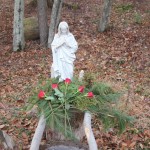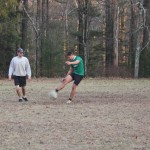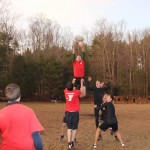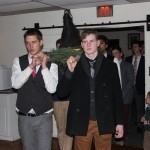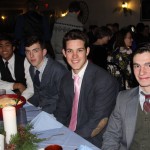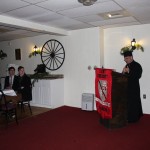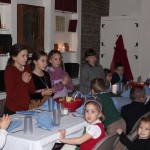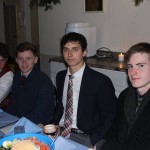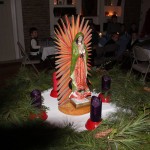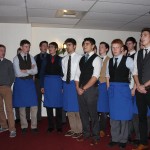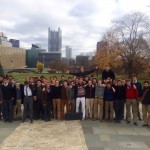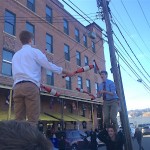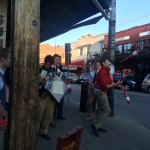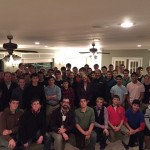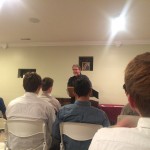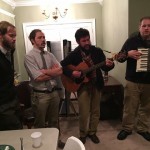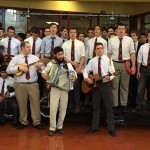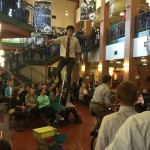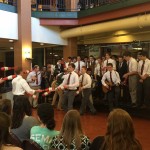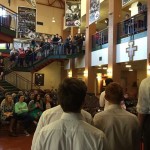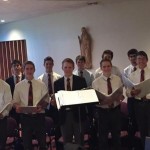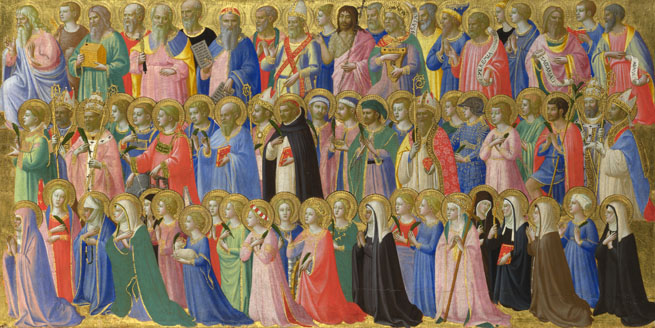
by Benjamin Strong, Teacher and Dorm Father
Fathers, faculty, students, and friends, welcome to our feast, our funeral games, to celebrate the lives, or rather the deaths of those who have found life in death. To rejoice with those who will rejoice forever. You can’t count a man happy till he has passed through the valley of tears, and you can’t celebrate his life until he has died, until he has fought the good fight, until he has finished the course. And so must we all fight and race, and follow in the footsteps of those who have fought and raced before us. We must find the path, and the footprints of those who have gone before us to live in the Lord and whose lives ever show us the way. The traces that these holy ones have left for us are plentiful, but they are hidden. It is for us to find them, to dig them up like buried treasures, and let them be a light for us as we tread the road to the City of God and the inn at the end of the world.
And by following in the footsteps of saints, you never know what you will find. Now, let me tell you a story.
Once upon a time, in May of the year 2015, we set out to follow the path St. Francis left across Italy, from Florence, through Gubbio, and Assisi, to Rome. Of course, as tradition dictates, and the desire for adventure demands, we did not bring money, and relied on the goodness of God, and the generosity of those we met along the way to give us the gift of food or money in return for the simple gift of our street performances.
Unlike the Camino de Santiago, towns are sparse along the way, and often we would walk all day to arrive at a tiny town in the mountains, where a meal seemed unlikely, but always appeared out of nowhere in the most unexpected and marvelous way. We were continually humbled by the generosity of the people, and the providence of God, which always provided an abundance of good things for us.
On the 7th or 8th day, we were leaving Goubio, and after visiting the chapel where the bones of the wolf were buried, we set out for what promised to be a long and difficult day of walking to a tiny town , called Biscina, consisting of one farm house , that set on top of a mountain in Central Italy.
It was a difficult walk, that led off the beaten path through fields, over creeks, and up a winding mountain path, that clung to the side of the mountain, with the mountain on one side, and a cliff on the other. When we finally crested the mountain, we looked down on where we would be spending the night, and with the end of the day’s journey the beauty before us took on a new luster, as it always did after a long, difficult, and tiring day. We sat down on the side of the mountain under a tree, and satisfied our honest appetites, earned throughout the day, with a simple meal of bread cheese and wine. It is always a striking how your eyes are opened by hardship to the simple joys of life. We enjoyed our meal, and each others company overlooking the green and rolling hills of Italy. W e tasted the joy the gypsy knows, the freedom nothing mars, The golden treasure gates of dawn, the mintage of the stars.
It was about 6:30 or so, and the sun was setting slowly in the West, bathing the entire scene in the golden glory of the evening. About 150 yards from where we were sitting, down a long path, shaded on either side by trees, was a huge, ancient abandoned castle, that, after we had eaten, were eager to explore. As I walked down the path I heard bagpipes, and saw the silhouette of David Prezzia in the window of a tower of the castle. It was a beautiful scene; the sunset, the lush greenery, the old castle.
As we reached the entrance, we realized we had stumbled upon the castle of a villain, the castle of the infamous count Ugolino, who was a traitor both to his country and to his children, who, according to Dante, is embedded in a block of ice in hell, cursed by an eternal hunger, and to forever consume and his enemy in a gruesome and terrible way.
The courtyard of the castle was very much overgrown, and there was the remnants of a path, with tangled shrubs making a sort of tunnel to a grove of trees just left of the castle. John Pollock, Kaleb Cress, JD Lejune, and I ducked into the tunnel, pushing aside the thorny vines and branches till we came to a building surrounded by trees. We recognized it to be a church … a very old church, from the dates we found, we guessed it was built sometime in the 12 or 13 hundreds. It was a small building, maybe 30’x50’. The roof was falling in one corner, and the sun shone through the dust that hung in the air, filling the church with a faint musty light. There were three altars. In the center of the church was a small, simple main altar, set on a platform of stone slightly raised above the rest of the floor of the church. The two side altars looked much older, and were made simply from dry laid stones, and set atop with a marble slab.
As we made our way to the front of the church, we noticed, to the left of the main altar, a dark rectangular opening in the wall, and beneath it, a pile of bones. Beside the bones we saw a stone plaque, on which we could make out a name, Giulia Peronetti. She had been buried in the wall of the church, and when the wall had shifted, the grave cracked open and fell to the ground below.
We stood in silence, not quite knowing what to do, when a thought struck us. Altars are set with first class relics… but surely there was no way that they could be left here abandoned. Relics are removed when a church is abandoned. With our hearts in our mouths, we moved toward the main altar. In the center of the altar top, was not an empty hole, but a small marble rectangle, sealed in place with plaster, flush with the top of the altar. We did not know what to do! Should we remove the stone? Or should we leave them there to decay with the church, or to possibly be desecrated by vandals, who had left evidence of satanic rituals in the castle? Or maybe we would be automatically excommunicated if we touched them? It was decided, after much breathless discussion, that we would collect the bones that had fallen from the wall, and reinter them at the foot of the main altar, below the floor, and we would remove the relics, and take them back to be venerated as they should be.
Night was falling, and John Pollock and Kaleb Cress carefully sifted the dirt for any bones… and black scorpions ran around their hands as they worked. JD and I carefully began carving out the
plaster that sealed in the altar stones. We spoke in whispers as we raced against the coming night.
When the last of the plaster had been removed, we all prayed the Our Father then lifted the stones from all three altars, to reveal, beneath each one, a metal canister, tied with a red ribbon, and set with an episcopal seal.
As night fell, we knelt in the dark before the relics we placed on the main altar, before the pit we dug in the floor where the bones of the Giulia lay. We prayed the rosary in the dark, and afterward, lit torches, touched each relic to the bones, sprinkled them with holy water, then covered them once again and ended with the prayer for the dead.
…. And we brought the relics with us, so that we might all be touched by them here.
These relics are a beautiful symbol of our mission as a school and as Catholics—to strive, to seek, and to find the lost vestiges, the forgotten fragments of goodness, truth, and beauty that have been swallowed up in the ruins of culture, and to reclaim that which is holy out of an ancient villain’s lair, to resurrect the relics of our Catholic heritage that we may partake in the Resurrection. To re-enshrine the treasures that have been forgotten, and to treasure them in the shrine of our hearts.
The almost forgotten footstep left in the wake of the great saints of Christendom, often lead to a villain’s lair, where songs and poems tell us of a rescuing, a reclaiming for the light, that which is under the shadow.
“They rush in red and purple from the red clouds of the morn,
From temples where the yellow gods shut up their eyes in scorn;
They rise in green robes roaring from the green hells of the sea
Where fallen skies and evil hues and eyeless creatures be;
On them the seavalves cluster and the grey seaforests curl,
Splashed with a splendid sickness, the sickness of the pearl;
They swell in sapphire smoke out of the blue cracks of the ground, – They gather and they wonder and give worship to Mahound.
And he saith, “Break up the mountains where the hermitfolk may hide, And sift the red and silver sands lest bone of saint abide,”
These terrifying lines from Chesterton’s Lepanto makes it very clear that something is hidden, and must be sought after and rescued. The forces of evil are sifting the ashes of culture, looking to find the last sparks of truth, and if not to extinguish them, to hide them beneath the confusion and noise of modern culture.
But all is not lost, for we have been given the light of truth to hold in the face of the shadow, a light that will shine brightest when the darkness is about us, a light for us in dark places, when all other lights go out. As the forces of evil loom before us, the call for heroism, the call for for saintliness, rings out from a saintless world. And the ancient path carved out by the great hearts of old often leads to a war.
“The last knight of Europe takes weapons from the wall,
The last and lingering troubadour to whom the bird has sung, That once went singing southward when all the world was young, In that enormous silence, tiny and unafraid,
Comes up along a winding road, the noise of the Crusade.”
We must become those last knights, Crusaders, explorers in search of treasure, knights rescuing the forgotten, misplaced, drowned out, lost relics of our civilization: the pageantry of music and poetry, the radiance of true friendship, the light of wisdom, the splendor of joy. We must rediscover the narrow and winding path of self sacrifice and generosity, following the footsteps of those who have gone before us. The last troubadours, singing the songs of the incarnation, telling the tales of redemption. Standing tiny, but unafraid to fight the good fight, in the enormous silence, with the stillness of a heart that rests in the assuredness, that however fierce the battle is raging, however dark the hour, the gates of hell will not prevail, and the light cast forth from hearts aflame with the love of Christ will illuminate the way for those around them. It will shine as a beacon to lead those lost, through the darkness of this life, to the eternal city, wherein dwells the light of light, the treasure that is the luster of all other treasure, the treasure which is Christ.




